Victoria, BC, 26 February 2024: Interregional (long-distance) public transit service is currently infrequent and expensive on Vancouver Island. For example, there are only four daily trips between Duncan and Victoria with $10 one-way fares, and only seven daily trips between Nanaimo and Duncan with $7.50 one-way fares, although that is one of British Columbia’s busiest travel corridors with tens of thousands of daily trips.
A new organization, Better Island Transit (BIT), advocates for more frequent and affordable bus service between central and southern Vancouver Island, with at least hourly service and $5 maximum fares between major cities, so a trip from Nanaimo to Victoria would cost no more than $10. It also advocates for better transit services on other provincial highways.
“Inadequate public transit is unfair and inefficient,” explains BIT President Todd Litman. “It deprives non-drivers of independent mobility, increases drivers’ stress and costs, and exacerbates traffic problems on Island roadways. Frequent and affordable interregional bus service is a quick and cost-effective solution to many transportation problems.”
The poor state of Vancouver Island’s public transport became the butt of jokes last year when contestants in BBC’s Race Across the World discovered how difficult it is to travel from Victoria to Port Hardy without a car (“BBC reality show contestants dumbfounded by British Columbia’s poor public transit”). However, this lack of public transit is not a joke for tens of thousands of Island residents who cannot, should not, or prefer not to drive on busy highways.
Frequent and affordable bus services connecting central and south Vancouver Island would help achieve many regional and provincial goals including more independence and opportunity for non-drivers, affordability, reduced driver stress, reduced congestion, traffic safety, emission reductions, better access to recreation areas, and rural economic development. Motorists benefit from reduced traffic problems and chauffeuring burdens. It would ensure non-drivers receive their fair share of transportation infrastructure investments.
“Interregional bus transit is the neglected stepchild of the transportation planning community,” says BIT Vice President Alastair Craighead. “The Ministry of Transportation plans interregional highways but not transit services, BC Transit plans local transit services but not interregional services, and several community organizations promote passenger rail, but no provincial organization monitors interregional transit needs, or plans, finances and advocates for basic long-distance bus services. BIT will fill that gap. If the province is serious about reducing single occupant vehicles and reducing our carbon footprint it needs to provide an affordable alternative.”
The recent Island Coastal Inter-Community Transportation Study shows that many Vancouver Island residents want interregional transit services. The Ministry of Transportation and Infrastructure is spending hundreds of millions of dollars to expand Island highways. In 2023, the provincial and federal governments announced a $249 million new public transit funding in BC, and the province announced $5 million to support Northern BC bus services plus an additional $18 million for Vancouver Island rail planning. However, there are no current plans to improve Vancouver Island bus services.
To serve growing needs British Columbia must establish a quick, nimble and responsive planning process for interregional transit. This should ensure that every major highway has public transit services.
The #61 bus route between Sooke and Victoria demonstrates that travellers will choose bus transit if it is frequent and affordable. That route has 43 daily trips starting before 6:00 am and continuing after midnight, with $2.50 one-way fares. It serves more than 20% of peak-period trips and ridership is growing.
“All we want,” Explains Litman, “is the same quality of transit service between Nanaimo and Victoria as currently exists between Sooke and Victoria. We don’t want to leave people behind.”


